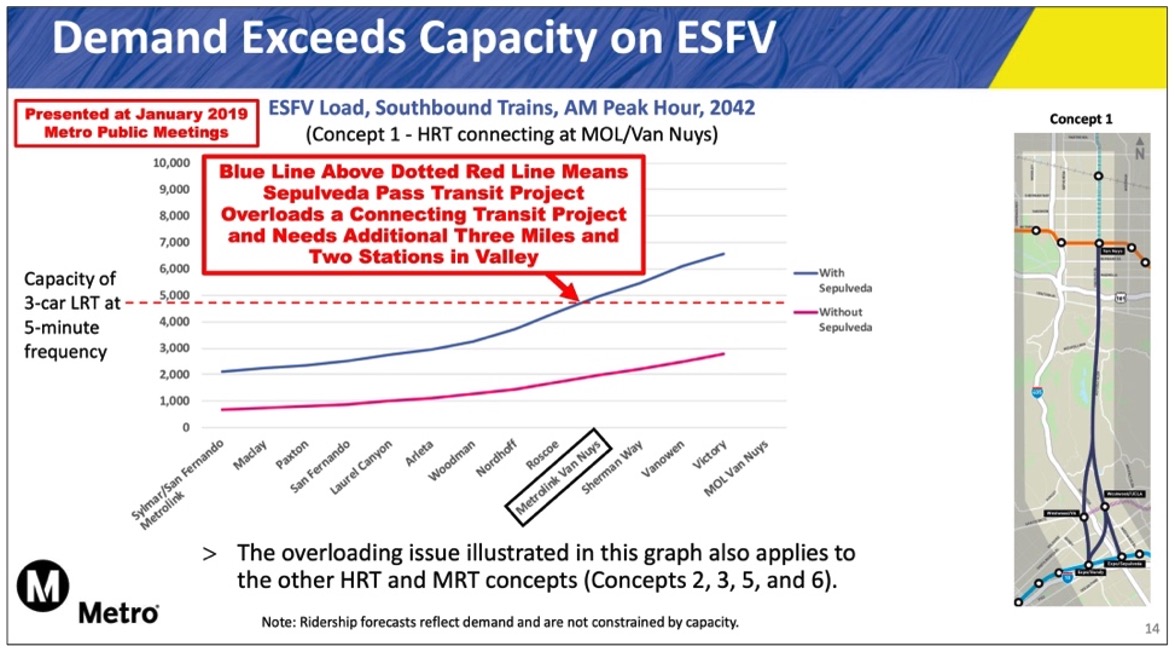Comments
LA TRANSPO -
[This is the sixteenth article in a series examining whether Metro can be a trusted steward for the Sepulveda Pass Transit project.]
The ninth of my 20 questions to Metro CEO Stephanie Wiggins asked: “Why didn’t Metro increase the STCP budget in 2019 per Measure M procedures when a Metro ridership analysis error required lengthening the STCP project route by 20% and added two additional Valley stations? At Metro’s January 2019 public meetings, former STCP Project Manager Cory Zelmer presented a chart that showed errors in Metro’s ridership analysis. These errors required adding about three miles to the Valley-side STCP route to prevent overloading passenger capacity for Metro’s future East San Fernando Valley [ESFV] Transit Corridor Project. This seemed a perfect opportunity for Metro to increase the STCP budget, as allowed by Measure M, but they chose not to. The public needs to understand why Metro chose not to adjust the budget.”
Metro’s answer called the errors refinements, again promised updated costs in the future, and ignored the real question about increasing the Measure M budget: “All six of the project alternatives, both heavy rail alignments and monorail alignments, were lengthened in 2019 based on the analysis contained in the Feasibility Study. The study anticipated heavy ridership demand on the East San Fernando Valley Light Rail corridor and the Metrolink Antelope Valley corridor. These were not errors, rather they were refinements based on the analysis and additional data. Additional costs related to these refinements will be captured in the cost estimates currently under development as part of the environmental review process.”
“Errors” is the correct word, not refinements. In writing Measure M in 2016, Metro developed preliminary concepts and cost estimates for each of its projects. The Sepulveda Pass Transit project’s concepts ran from Pico Blvd on the Westside to the Orange Line in the Valley, with a few going further north. At their January 2019 public meetings, Metro presented the not-easy-to-understand chart below, noting an “overloading issue” that required all concepts be extended north to the Van Nuys MetroLink station. This added almost three miles to routes and two additional Valley stations. Metro failed to mention that the longer routes would significantly increase project costs. Today, this increase amounts to about $5 billion for Metro’s longest Alternative 5 subway.

The cost increase is so large because subways today cost more than $2 billion per mile to build. The Federal Transit Administration (FTA) recently validated this for the San Jose Bay Area Rapid Transit Extension project. This 6-mile BART extension has 5 miles of single-bore subway and 1 mile of above-ground rail. Its original cost estimate ten years ago was $4.4 billion. FTA now projects almost triple that original cost at $12.7 billion, or $2.1 billion per mile – and it’s not even all subway. It won’t open until 2037. Apply this to the Sepulveda Pass Transit project’s 14-mile Alternative 5 subway and you get a $30 billion cost and 2040++ opening date.
It has long been obvious that Metro’s Sepulveda Pass Transit subway alternatives will cost three or more times Metro’s $8 billion Measure M budget. My ninth question asked Metro why they didn’t increase the Measure M budget in 2019 to account for the increased route length. Measure M (Section 11.a) allows the Metro Board to amend project costs with a two-thirds vote. This would have given them at least a $10 billion budget today. Metro didn’t consider this necessary then and now have $30 billion subway alternatives and only $8 billion Measure M budget to build them. Sounds like they would be happy for any additional budget right now – because project costs keep going up the longer Metro delays.
(Bob Anderson is a nuclear engineer with 50 years engineering and business development expertise in the aerospace and high-technology sectors. He is VP and Transportation Committee Chair of the Sherman Oaks Homeowners Association. Contact him at [email protected].)
















